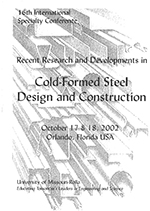Session Dates
17 Oct 2002
Abstract
Failure of thin-walled cold-formed members in compression is always characterized by a local plastic mechanisms, either a stub or slender column is referred. Starting from this observation, the authors suggest for the interactive local-overall buckling analysis to use instead of traditional "effective section", the sectional plastic mechanism strength. This is a new approach and for this reason it is compared with another one, namely the Direct Strength Method. Experimental results and advanced FEM simulations are used to evaluate the two methods. Comparisons with European and American relevant design codes are also presented in the paper.
Department(s)
Civil, Architectural and Environmental Engineering
Research Center/Lab(s)
Wei-Wen Yu Center for Cold-Formed Steel Structures
Meeting Name
16th International Specialty Conference on Cold-Formed Steel Structures
Publisher
University of Missouri--Rolla
Document Version
Final Version
Rights
© 2002 University of Missouri--Rolla, All rights reserved.
Document Type
Article - Conference proceedings
File Type
text
Language
English
Recommended Citation
Dubina, Dan and Ungureanu, Viorel, "Plastic Strength of Thin-walled Members" (2002). CCFSS Proceedings of International Specialty Conference on Cold-Formed Steel Structures (1971 - 2018). 4.
https://scholarsmine.mst.edu/isccss/16iccfss/16iccfss-session4/4
Plastic Strength of Thin-walled Members
Failure of thin-walled cold-formed members in compression is always characterized by a local plastic mechanisms, either a stub or slender column is referred. Starting from this observation, the authors suggest for the interactive local-overall buckling analysis to use instead of traditional "effective section", the sectional plastic mechanism strength. This is a new approach and for this reason it is compared with another one, namely the Direct Strength Method. Experimental results and advanced FEM simulations are used to evaluate the two methods. Comparisons with European and American relevant design codes are also presented in the paper.



